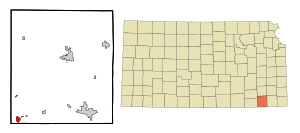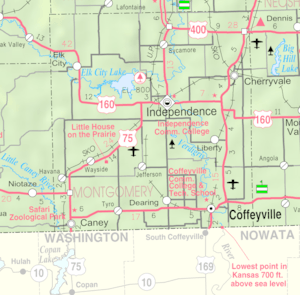Caney, Kansas facts for kids
Quick facts for kids
Caney, Kansas
|
|
|---|---|

Location within Montgomery County and Kansas
|
|

|
|
| Country | United States |
| State | Kansas |
| County | Montgomery |
| Founded | 1869 |
| Incorporated | 1887 |
| Named for | Caney River |
| Area | |
| • Total | 1.35 sq mi (3.50 km2) |
| • Land | 1.35 sq mi (3.50 km2) |
| • Water | 0.00 sq mi (0.00 km2) |
| Elevation | 778 ft (237 m) |
| Population
(2020)
|
|
| • Total | 1,788 |
| • Density | 1,324/sq mi (510.9/km2) |
| Time zone | UTC-6 (CST) |
| • Summer (DST) | UTC-5 (CDT) |
| ZIP code |
67333
|
| Area code | 620 |
| FIPS code | 20-10375 |
| GNIS ID | 485551 |
Caney is a city located in Montgomery County, Kansas, in the United States. In 2020, about 1,788 people lived there.
Contents
History of Caney
Caney was started in 1869. It got its name from the nearby Caney River. The first post office opened in Caney in May 1870.
In 1887, a railroad line was built through Caney. The town officially became a city in the same year.
Caney has a long history with the petroleum industry, which deals with oil and gas. In 1906, a very large gas well caught fire in the area. This fire burned for 15 days! Many people came to see the huge flames, which shot over 150 feet into the air.
In 1909, the first Kanotex Refining Company was built in Caney. Today, a company called CVR Energy has a large oil pipeline system. This pipeline can move a lot of crude oil from Caney to their oil refinery in Coffeyville, Kansas.
Geography and Climate
Caney covers a total area of about 1.35 square miles (3.50 square kilometers). All of this area is land.
Caney's Climate
The weather in Caney has hot, humid summers. The winters are usually mild to cool. Caney has what is called a humid subtropical climate. This means it gets a good amount of rain all year round.
Population Facts
| Historical population | |||
|---|---|---|---|
| Census | Pop. | %± | |
| 1890 | 542 | — | |
| 1900 | 887 | 63.7% | |
| 1910 | 3,597 | 305.5% | |
| 1920 | 3,427 | −4.7% | |
| 1930 | 2,794 | −18.5% | |
| 1940 | 2,629 | −5.9% | |
| 1950 | 2,876 | 9.4% | |
| 1960 | 2,682 | −6.7% | |
| 1970 | 2,192 | −18.3% | |
| 1980 | 2,284 | 4.2% | |
| 1990 | 2,062 | −9.7% | |
| 2000 | 2,092 | 1.5% | |
| 2010 | 2,203 | 5.3% | |
| 2020 | 1,788 | −18.8% | |
| U.S. Decennial Census | |||
2020 Population Count
The 2020 United States census found 1,788 people living in Caney. There were 761 households. About 28.5% of these households had children under 18. The average age of people in Caney was about 39.1 years old.
2010 Population Count
In the census of 2010, Caney had 2,203 people. The average age was 35.9 years. About 25.8% of the people were under 18 years old.
Local Events
Mayfest is a yearly event in Caney. It celebrates school alumni and other town activities. There is also a "Fourth & Live Concert Series" that takes place.
Education in Caney
Students in Caney attend schools in the Caney Valley USD 436 public school district.
Famous People from Caney
- Clancy Hayes, a jazz musician
- Kenneth McFarland, an educator and school leader
- Glenn Shafer, a statistician
- Rosalie Wahl, a former judge on the Minnesota Supreme Court
See also
 In Spanish: Caney (Kansas) para niños
In Spanish: Caney (Kansas) para niños

